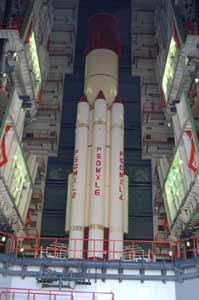|
Bangalore: The Indian Space Research Organisation (ISRO) has completed the design of the Chandrayaan-2 spacecraft, slated to be the agency's next mission to the moon. To be conducted jointly with Russia, the mission will involve putting a lander and a rover on the lunar surface to collect and analyse samples of lunar soil.  "Right now, the design has been completed. We had a joint review with Russian scientists here," ISRO chairman, G Madhavan Nair said. "Right now, the design has been completed. We had a joint review with Russian scientists here," ISRO chairman, G Madhavan Nair said.
The proposed Chandrayaan-2 design will have an orbital flight vehicle constituting an Orbital Craft (OC) and a Lunar Craft (LC) that would carry a soft landing system up to Lunar Transfer Trajectory (LTT). The mission is slated for the end of 2012. The target location for the lander/rover would be identified using data collected by the ongoing Chandrayaan-1 mission. Chandrayaan-1 is India's unmanned mission to the moon, which was launched on 22 October last year. It is currently orbiting the moon at an altitude of 200km. Under the division of responsibility, ISRO will develop the orbiter, while Russia will design and construct the lander and the rover. Additional scientific payloads may be taken onboard from international contributors. With the completion of the design process of the Chandrayaan-2 spacecraft, ISRO chief Madhavan Nair said the next step would be to construct a prototype. This, he said, would happen next year. Nair said the organisation had learnt a number of lessons from the Chandrayaan-1 mission, particularly on the thermal and redundancy management fronts. These lessons would result in improvements being made to systems in Chandrayaan-2. "I think we have got very valuable inputs on the heat radiation from the moon's surface and so on. Accordingly, the thermal design of the future aircraft can be addressed," Nair said. "Radiation is much beyond our expectations, so we will have to see how the radiation hardening has to be strengthened." "Then, in redundancy management also, there are some inputs which are available from this (Chandrayaan-1), which we will try to incorporate in Chandrayaan-2." Nair said contingency operations undertaken by the organisation following the failure of Chandrayaan-1 spacecraft's onboard star sensor earlier this year have worked well and "this is (now) as precise as it was earlier." "We are able to locate the cameras at specific locations," he said noting some of the stereo images that have come recently. "The fact that we were able to point the spacecraft towards the earth and capture the (recent) solar eclipse, shows the accuracy of the system." Nair also said that 95 per cent of the scientific objectives of Chandrayaan-1 mission had been achieved. "Another five per cent, what's left out, we will try to take up in the next season which is starting in October so that we can complete all the observations." Nair said India's ground station at Byalalu on the city outskirts had provided precision which was as good as the NASA station. "We are comparing both the tracking results." As for US and European clients, who had put payloads on board Chandrayaan-1, Nair said, "They have got more than sufficient data with them and are extremely happy. Now, Indian and foreign scientists are working together to analyse the data and they have promised some results before the year end." He also mentioned that three-dimensional pictures of the moon would soon be available. Nair said that an upcoming meeting of ISRO scientists regarding Chandrayaan-1 would look into all aspects of its functioning and ensure that it has not "left out anything". "Today, we know that there is no redundancy on board. So, if further failure...if it happens, then we will be crippled. "So, all the scientific objectives have to be completed in the remaining time. We will discuss with them what is pending and what needs to be done. Secondly, if some of them have got preliminary findings then we will try to make an assessment."
|